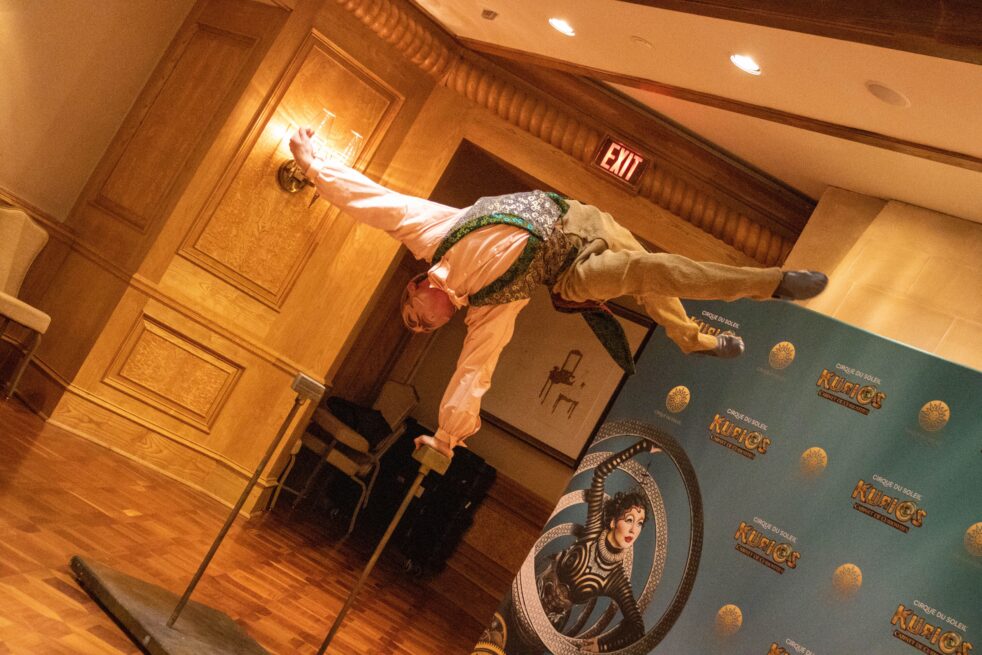On Oct. 6, the iconic big top of Cirque du Soleil will open its doors to the city of Atlanta, the place that the “KURIOS – Cabinet of Curiosities” will call home until late December. The 35th show since the company’s founding in 1984, traveling publicist Rebecca Williams describes “KURIOS” as a “nod to the industrial revolution, [featuring homages to] the invention of the steam train, electricity [and] the gramophone.”
The Technique attended Cirque du Soleil’s advance media day last Tuesday, Sept. 20, to see a small preview of some of the talent highlighted within the upcoming show and participate in a question-answer session to find out what really goes into putting on a show of Cirque du Soleil-caliber.
The event began with a short but exceptional performance by Andrii Bondarenko, who has a solo act in “KURIOS” as a hand balancer. The Ukrainian artist started in the athletic circuit in his home country of Ukraine, winning silver and two gold medals in three different acrobatic world championship competitions before moving into circus arts.
He joined Cirque du Soleil in 2011 and has been with “KURIOS” since its development in 2014. During the Q&A panel, he explained the difference between acrobatics in the world of sports and the world of circus.
“When [you’re competing] in sports, you just have to be precise and that’s it. But when you’re onstage, you have to be [an] artist,” Bondarenko said. “Even if you do [make a] small mistake, people — the audience — they don’t care. You can play with [it] and they still love it.”
According to Bondarenko, all Cirque du Soleil artists learn to apply their own makeup and hair pieces, which differ between every show, at the company headquarters in Montreal, Canada. While his hair and makeup only takes 40 minutes, other characters could need a whole two hours for their looks. Bondarenko’s particular act has him often upside down and his costume consists of what appears to be brightly colored 1920s formal wear.
“[The clothes] need to look good onstage and also be comfortable for the artist to perform in,” Bondarenko said. Therefore, each costume is custom-made specifically to the performers’ measurements, also taken in Montreal.
During the tour, the team puts on approximately eight to ten shows each week, with three shows on Saturdays. The intense schedule means that, for the onstage performers, not taking care of themselves could lead to injury and/or early retirement. Many performers will stay after the shows to stretch and condition.
On show days, Bondarenko warms up with a 90-minute routine before the first show, then precedes any following shows with a much shorter warmup, usually around half an hour.
Like any other live production though, Cirque du Soleil does not just rely on the onstage artists to bring the circus to life. The technicians and specialized staff traveling with the show play an instrumental role in ensuring that “KURIOS” runs smoothly no matter where they are.
Setting up the cirque site takes approximately an entire week (though tearing it down only takes two days). Traveling with roughly 66 trucks, 2,000 tons of equipment (including 400+ props) and over 800 costumes, the touring team is quite literally a small village.
According to Williams, 110 people move with the show, with only 49 of them being performers. The company also employs roughly 150 locals in each city they stop.
The technicians of “KURIOS” are responsible for anything and everything from lighting, rigging, sound, carpentry and props.
In addition to those who have consistent roles in the offstage “choreography” of the show, there are also people who act as “swing techs.” Similarly to swings on Broadway, swing techs are cross-trained in multiple “tracks,” allowing them to bounce between different jobs as needed.
The wardrobe team helps to maintain every performer’s costumes, many of whom have additional “specialties” within the department.
“We have a girl called Jordan who looks after wigs, mustaches [and] all of the hats in the show … [and] a guy called Ryan, who is a shoe technician, but also very skilled in working with non-fabric costumes,” Williams said.
The heart of the Cirque du Soleil mobile village is the kitchen tent, which provides a jaw-dropping 300-400 meals each day to the show’s cast and crew.
Tasked with feeding “110 people from 27 different nationalities … from [performers] like Andrii to riggers who are maintaining the show every night …,” the kitchen team still manages to provide different options, including those accommodating allergies or other dietary restrictions, “which is amazing,” Williams said.
Having just finished its two-month stay in Washington, D.C., “KURIOS – Cabinet of Curiosities” will premiere at Atlantic Station in Atlanta in less than one week. It will remain there until Christmas Eve, its yellow and blue tents visible from off I-75/85.
The show is an imaginative story of a hidden world full of wonder and innovation, made possible not just by the gifted artists who merge reality and fantasy onstage but also by the multitude of tour members who handle all the magic that needs to happen offstage.
Tickets can be found at cirquedusoleil.com/kurios.
